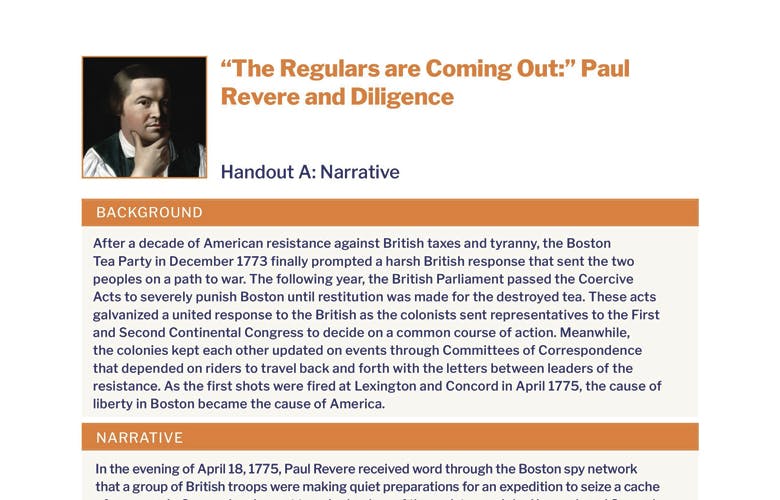The Regulars are Coming Out: Paul Revere and Diligence – Handout A: Narrative
BACKGROUND
After a decade of American resistance against British taxes and tyranny, the Boston Tea Party in December 1773 finally prompted a harsh British response that sent the two peoples on a path to war. The following year, the British Parliament passed the Coercive Acts to severely punish Boston until restitution was made for the destroyed tea. These acts galvanized a united response to the British as the colonists sent representatives to the First and Second Continental Congress to decide on a common course of action. Meanwhile, the colonies kept each other updated on events through Committees of Correspondence that depended on riders to travel back and forth with the letters between leaders of the resistance. As the first shots were fired at Lexington and Concord in April 1775, the cause of liberty in Boston became the cause of America.
NARRATIVE
In the evening of April 18, 1775, Paul Revere received word through the Boston spy network that a group of British troops were making quiet preparations for an expedition to seize a cache of weapons in Concord and arrest two ringleaders of the resistance, John Hancock and Samuel Adams. Revere prepared to ride out and warn the countryside that the British were coming at no small risk to himself. The British had thousands of troops in Boston, warships in its harbor, and roving patrols to capture riders such as Revere. However, Revere had ridden through danger before; during the past few years had been a key messenger in spreading news in the American resistance.
Paul Revere was the most indefatigable and famous of American riders. He worked as a silversmith in Boston, which was one of the main centers of opposition to the British. He was a dedicated patriot and member of the Sons of Liberty, the militia, and a local Congregationalist church. After the Boston Massacre, he had created the most important engraving that was used as propaganda denouncing the redcoats for killing five colonists. Between 1773 and 1775, he had ridden thousands of miles across the colonies to help the leaders of the different areas to communicate with each other and form an effective united response to British policies. Most notably, he brought the Suffolk Resolves to the First Continental Congress, which proclaimed that Massachusetts owed “no obedience” to the Coercive Acts and claimed the rights the colonists were “justly entitled by the laws of nature, the British Constitution, and the charter of the province.”
None of Revere’s rides were as important—or as dangerous—as the midnight ride on April 18 to warn the countryside that the British were on the march. Because of the possibility of capture, two other riders were dispatched on various roads to Lexington and Concord. Leather tanner William Dawes sped out on horseback, and an unidentified rider also rode out. Meanwhile, as two lanterns were placed in the steeple window of Old North Church to signal that the British were coming by sea, Revere rowed across the Charles River, narrowly eluding a British ship.
Revere reached land and galloped off toward Lexington, outrunning two British regulars who spied him and gave chase until the silversmith disappeared into the night. He reached Lexington and went to the home where Hancock and Adams were in hiding in order to warn them to leave. He may not have yelled “The British are coming,” but he did tell the militiamen who were guarding the house that, “The Regulars are coming out!” Other members of the militia were roused from their beds and soon assembled on the town green with their muskets, in case of trouble. Shortly thereafter, Dawes arrived (though the mysterious rider had apparently been captured and detained), and the pair decided to continue on to Concord. As they were riding, they met up with Dr. Samuel Prescott, who offered to help. The trio leapfrogged to every farmstead along the way, informing the inhabitants that the redcoats were on the march. Soon, the alarm was raised with the tolling of church bells and firing of signal guns.
The riders dashed along the road until they were suddenly ambushed by four armed British regulars who emerged from their hiding spot. The redcoats prevented the riders from bolting and threatened to shoot them. As six more regulars appeared to interrogate the prisoners, Dawes saw an opportunity and escaped their captors, though he was soon violently thrown from his horse and had to limp back to Lexington. Revere was roughly handled by the British troops, who pistol-whipped him in the back of the head and insulted him. Finally, the British decided to release Revere, but not before confiscating his horse. Thinking of the public cause more than his own safety, Revere walked to Lexington to help carry a trunkful of important papers owned by Hancock and Adams. He arrived just as the “shot heard round the world” was fired.
After the smoke cleared, eight Americans lay dead and others gravely wounded. The British then marched off towards Concord. Revere’s own part in the night’s events were over, but he had diligently completed his assigned task with great courage. The British troops eventually searched for the hidden weapons in Concord and engaged with the militia arriving from the surrounding towns. After a sharp exchange, the British desperately fought their way back to Boston as the Americans fired from behind rocks, fences, and barns.
Paul Revere was diligently committed to the American cause for liberty. His travel between different cities helped forge an American unity and identity as the colonists from disparate parts of the country communicated their mutual support against a common foe. Additionally, Revere was one of the first Americans to put his life on the line to serve a cause higher than himself during his most famous ride.
